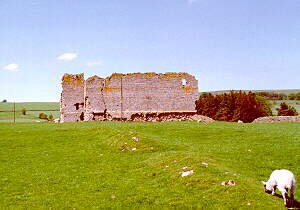Carlisle
|
WARS AND BANDITRY ON THE ANGLO-SCOTTISH BORDERS
Strife between England and Scotland, whether the official wars of the kings or the brigandage of private individuals and families, was for 700 years and more the chief influence on the history of Cumbria. This article describes that strife so as to put into context the references to 'Scots raiders', 'Jacobite Rebellion' and other such terms used elsewhere on this site.
The Border between England and Scotland was drawn up in the middle of the 1200's, about two-thirds of the way through a century of unusual peace between the two kingdoms. When that peace ended in the 1290's there would not be another such period until the late 1700's, 500 years later.
The 'official' wars between England and Scotland began in the 1000s with the defeat of the Norse King Dunmail in 945 by the Saxon King Edmund. From then until 1070 Cumbria was ruled by the Kings of Scotland. Gospatric, an Anglo-Saxon Earl of Northumberland (the neighbouring county) recaptured Cumbria in that year, and it passed to his son Dolfin in 1072. In 1092 Dolfin was driven out of the kingdom by William II of England (called Rufus because of his red hair). Rufus was the second son of William the Conqueror. It was Rufus who is responsible for Carlisle Castle and his brother Henry I (who succeeded him) built a Priory where the Carlisle Cathedral now stands.
By 1135 England had lapsed into civil war and the Scots marched on Carlisle reoccupying the Castle. The Scots remained in control of the county until 1157 when Henry II of England restored it once more to English control. The Scots Kings unsuccessfully pressed their claims on Cumbria until the English King John (1199 on) became so unpopular with the citizens of the county through heavy taxation that King Alexander II of Scotland met with no resistance when he invaded in 1216. Alexander was eventually paid to quit the county by Johns son Henry III.
Henry III was succeeded by Edward I who began to develop Carlisle as a military strong hold from which to launch attacks on the Scots. There followed more than 100 years of intermittent warfare between the two countries, during which Carlisle in particular suffered terribly, though no settlement in the Borders was safe.
The county saw no sustained period of peace between 945 and 1560 when the Treaty of Edinburgh resulted in the withdrawal of all English troops from Scotland.
During this time the devastation and destruction along the Border to monasteries, towns, castles, churches and settlements. Both sides were merciless in their treatment of the populations they assailed. The unreasoning savagery of Wallace and Bruce in northern England was matched in brutality only by the expeditions of the Kings Edward I and III, and later the Earl of Surrey and others on behalf of Henry VIII. "Put all to fyre and sworde," said the Privy Council Order to Henry's army in 1544, " Edinborough towne, so rased and defaced when you have sacked and gotten what ye can of it, as there may remayne forever a perpetual memory of the vengeunce of God." And so it did, to this very day.
Thus are mythologies born, to be exploited centuries later by the latter-day successors to the kings and politicians and clerics whose religious and dynastic disputations gave them their sordid birth. The more that things change....
Page 2
History
Index
Copyright © EDGE 1997
|



